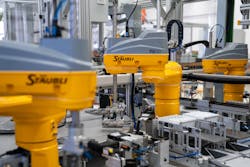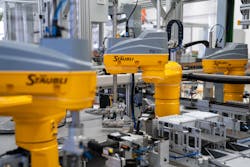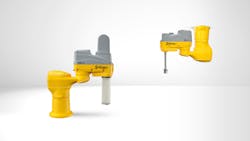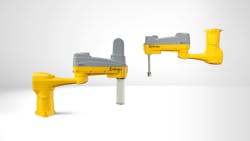At BH Sens, a Chinese automotive industry supplier, the production line for its tire pressure sensors assembles 10 components to form a ready-to-use tire pressure sensor. These sensors are built directly into the tire valve. To fully automate the assembly process for these sensors, BH Sens required several quality steps to be integrated to guarantee high availability and quick production turnaround to achieve its goal of making four million ready-to-use sensors per line—one every six seconds.
Flexibility was also required, as the assembly process produces three sensor variants using different printed circuit boards.
MMS Modular Molding Systems GmbH of Berndorf, Austria, develops interlinked and modular lines for the manufacture of plastic/metal hybrid components. MMS designed and built a compact, fully automated tire pressure sensor line for BH Sens’s tire pressure sensor assembly process.
“To guarantee continuous monitoring and documenting of test and measurement data during the production process, components are all assigned a data matrix code by a marking laser. These codes are scanned and assessed at every station,” explains Stefan Babka, designer and project manager at MMS.
Initial quality checks, such as voltage testing, are completed within six seconds before the components are transported to pressure chambers on a linear transport conveyor. In these chambers the airtightness of the sealed components is monitored. Next, the end-of-line test simulates communication with vehicle electronics to ensure that each individual sensor is 100% functional.
The whole process comes to an end on the rotary table, where the sensor is attached to the valve and the finished product is automatically screwed in place. This completed sensor/valve combination is then packaged for use as an original or aftermarket part.
Stäubli’s SCARA models were chosen by designers at MMS because of their interaction capability with the camera systems required to ensure correct component positioning, as well as to communicate with the Asyril flexible feeders used on the assembly line. MMS chose these Stäubli SCARAs because the movement of the components had to take place on four-axis robots, as six-axis robots would have been too slow for use in this environment.
The BH Sens production line undergoes at least 14 automated steps within a very compact area, so flexibility is key to allowing changes to be made to the systems without completely restructuring the hardware components. Not even the grippers need to be changed to accommodate the various components, according to Babka.
Production changeover is also made easier through the incorporation of an automatic clearing function into the Asyril feeder system. This function eliminates the need for operators to manually clear the conveyor, as all parts are automatically cleared from the feeder and transported further by conveyor.
About the Author
Jeanne Schweder
Contributing Editor, Automation World

Leaders relevant to this article:



